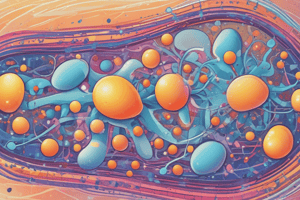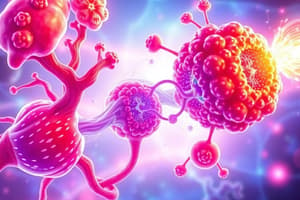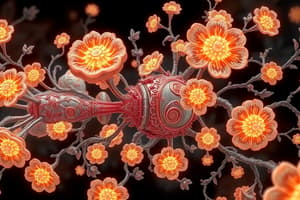Podcast
Questions and Answers
What is the primary role of ATP synthase in oxidative phosphorylation?
What is the primary role of ATP synthase in oxidative phosphorylation?
- Degrade ADP
- Catalyze proton pumping
- Transport electrons
- Synthesize ATP (correct)
The outer mitochondrial membrane is impermeable to ions.
The outer mitochondrial membrane is impermeable to ions.
False (B)
What is the function of the electron transport chain in mitochondria?
What is the function of the electron transport chain in mitochondria?
To facilitate the flow of electrons and generate a proton gradient.
The __________ membrane bears the components of the respiratory chain and the ATP synthase.
The __________ membrane bears the components of the respiratory chain and the ATP synthase.
Which of the following is NOT a component in the mitochondrial matrix?
Which of the following is NOT a component in the mitochondrial matrix?
Photophosphorylation occurs in chloroplasts.
Photophosphorylation occurs in chloroplasts.
What does the selective permeability of the inner mitochondrial membrane achieve?
What does the selective permeability of the inner mitochondrial membrane achieve?
Match the following components with their corresponding functions:
Match the following components with their corresponding functions:
What is the main purpose of oxidative phosphorylation?
What is the main purpose of oxidative phosphorylation?
Photophosphorylation occurs in mitochondria.
Photophosphorylation occurs in mitochondria.
What is the ultimate electron acceptor in photophosphorylation?
What is the ultimate electron acceptor in photophosphorylation?
Oxidative phosphorylation involves the reduction of O2 to ______.
Oxidative phosphorylation involves the reduction of O2 to ______.
Which of the following statements is true about oxidative phosphorylation and photophosphorylation?
Which of the following statements is true about oxidative phosphorylation and photophosphorylation?
Match the following processes with their descriptions:
Match the following processes with their descriptions:
Who introduced the chemiosmotic theory?
Who introduced the chemiosmotic theory?
The flow of electrons through a chain of membrane-bound carriers conserves free energy as a transmembrane ______.
The flow of electrons through a chain of membrane-bound carriers conserves free energy as a transmembrane ______.
Flashcards are hidden until you start studying
Study Notes
Oxidative Phosphorylation and Photophosphorylation
- Oxidative phosphorylation is the final stage of energy metabolism in aerobic organisms, synthesizing ATP through the oxidation of carbohydrates, fats, and amino acids.
- Photophosphorylation allows photosynthetic organisms to convert sunlight into ATP, the ultimate energy source in the biosphere.
- Both processes are responsible for the majority of ATP production across various organisms.
Cellular Locations
- In eukaryotes, oxidative phosphorylation occurs in mitochondria, while photophosphorylation happens in chloroplasts.
Chemical Reactions
- Oxidative phosphorylation reduces O2 to H2O, utilizing electrons from NADH and FADH2, independent of light conditions.
- Photophosphorylation oxidizes H2O to O2, using NADP as the electron acceptor, and is entirely reliant on light energy.
Mechanistic Similarities
- Mechanistically, oxidative phosphorylation and photophosphorylation share three main features:
- Both entail electron flow through a series of membrane-bound carriers.
- The free energy from this electron flow is harnessed to transport protons across a membrane, creating a proton electrochemical gradient.
- Protons flow back through specific proteins (ATP synthase), generating ATP from ADP.
Chemiosmotic Theory
- Proposed by Peter Mitchell in 1961, the chemiosmotic theory suggests that proton gradients across membranes serve as energy reservoirs for ATP synthesis.
- This theory has significantly influenced biological energy transduction understanding and offers insight into other processes like active transport.
Mitochondrial Structure and Function
- Mitochondria have two membranes: an outer membrane permeable to small molecules and ions, and an inner membrane that is impermeable without specific transporters.
- The inner membrane contains the respiratory chain and ATP synthase, while the mitochondrial matrix houses various metabolic pathways, including the citric acid cycle and fatty acid oxidation.
Historical Context
- The identification of mitochondria as the site of oxidative phosphorylation by Eugene Kennedy and Albert Lehninger in 1948 ushered in a new era of research on biological energy transduction.
Studying That Suits You
Use AI to generate personalized quizzes and flashcards to suit your learning preferences.





